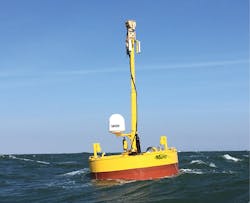DARPA eyes ocean surveillance with unmanned sensor floats
ARLINGTON, Va. - Officials of the U.S. Defense Advanced Research Projects Agency (DARPA) in Arlington, Va., issued a broad agency announcement (HR0011-18-S-0013) for the Ocean of Things program to develop environmental sensing and surveillance capabilities with unmanned floats.
DARPA wants to develop large networks of unmanned buoys to keep watch on large ocean areas for weather and ship traffic.
The DARPA Ocean of Things project has two thrusts: building low-cost persistent maritime floats that sense and report relevant data, and developing data processing to transform float data into useful information like vessel track reports.
Today, naval and commercial ships typically can only use onboard sensors for situational awareness. Using remote sensors from aircraft and satellites can be limited by fog, rain, cloud cover, and other environmental conditions. The DARPA Ocean of Things program will seek to correct these shortcomings, as well as provide ocean data to those who need it.
Floats in the Ocean of Things program will rely on commercial hardware to generate data autonomously and in real time in a low-cost approach that could enable industry to build large numbers of floats to cover large operating areas and provide data from areas where limited visibility exists today. Each onboard sensor mode will require research into efficient signal processing to conserve limited communications bandwidth and stored energy on a float, while making the most of information available from advanced analytic techniques. The smart float system will use a cloud-based architecture, find ways to visualize the dynamic capabilities of the system, and find new ways for operators to interact with large numbers of floats.
Contractors chosen for the first part will design and build floats for large-scale employment that periodically report environmental data like ocean temperature, sea state, and location, as well as report on operational activity. These floats will communicate to the computer cloud and receive commands via short data bursts to Iridium satellites.
Each float contractor will build 1,500 floats for sea testing. Each float will have a suite of sensors to measure position, motion, temperature, wind speed, salinity, humidity, and solar intensity, as well as a mission sensor for acoustic, magnetic, electro-optical, and RF measurement. From these sensors, DARPA researchers want the ability to detect, track, and classify surface ships and submarines.
Each float should cost no more than $500 in lots of 50,000 units, make the most of commercially available components, and be able to scuttle itself to avoid washing up on environmentally sensitive areas, marine protected areas, and coastal areas.
Contractors chosen for the data-processing part of the project will use cloud-based products and devise analytic techniques to process float data.
Companies interested should submit abstracts no later than 26 Jan. 2018. Full proposals are due no later than 23 March 2018. E-mail questions or concerns about the DARPA Ocean of Things project to [email protected]. More information is online at https://www.fbo.gov/spg/ODA/DARPA/CMO/HR0011-18-S-0013/listing.html.

